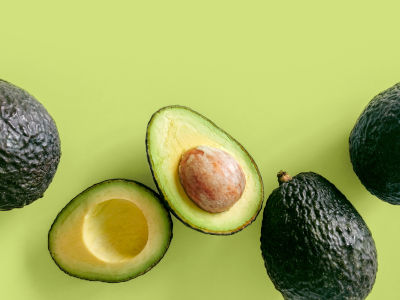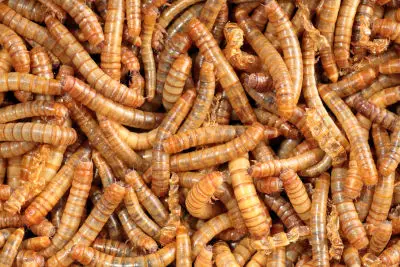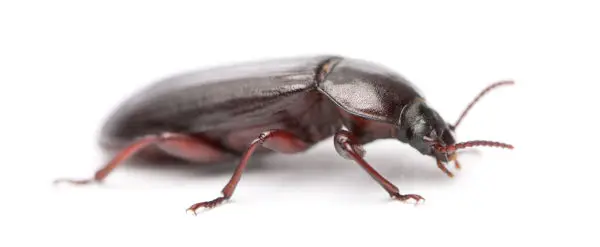Superworm vs Mealworm for Lizards (Difference/Size/Nutrition)
If you are thinking of feeding your lizards the best insects, you may be wondering if you should choose Superworms (Click here for the price of my best Superworm selection, on Amazon) or Mealworms. Let me explain…
What’s the difference between a Superworm and Mealworm? Superworms are typically five times bigger than Mealworms. They can last as Larvae (which is the state most Lizard keepers favor) longer, but Mealworms have the added benefit of being able to be refrigerated for storage.
| Are these foods dangerous for your Beardie? | |
| Avacado? Click here to learn, from this guide, if this food is dangerous |  |
| Superworms? Click here to learn, from this guide, if this food is dangerous |  |
Now that you know the general differences, let me explain in more detail. Such as how Giant Mealworms size up to Superworms, the nutritional differences and much more. Keep reading.
What’s the difference between a Superworm and Mealworm?
In this section, I am going to summerise the main differences between a Superworm & Mealworm. At a glance, they can seem very similar, if not the same. Especially when you compare the Superworm to the Giant Mealworm (more on that later).
About 5 Times Bigger
One of the more obvious differences is the size. But, before I continue, let me clarify, I am comparing the standard Mealworm with the Superworm, ok?
One of the major reasons for this size difference is the extra Chitin, as well as their shell. The downfall of this (well, for your lizard) is, they appear bigger, but they have less meat. However, they make up for this with a higher level of Calcium, Fiber and also fat.
What is Chitin, by the way?
According to the Oxford Dictionary, Its a fiber type substance that contains polysaccharides.
Not able to refrigerate
One of the biggest drawbacks with Superworms, when comparing them to Mealworms, is the fact that you can not refrigerate them.
But, why would you want to do that?
Simple, to prolong their lifespan in storage. When Mealworms are put in the fridge, they can last a long while. They will stay in a larvae state, in storage. Giving you time to feed them to your lizard. However, this is not possible with Superworms (More on this later).
What is a Mealworm, anyway?

Before we go any further, let me explain exactly what is a Mealworm. To make sure we are on the same page. According to Wikipedia, Mealworms (Tenebrio Molitor) are Mealworm Beetles in their Larvae form. This Beetle is known to be a species of the darkling Beetle.
This beetle has four key stages of growth, with one of them relevant to this article (the Larvae stage):
- Egg
- Larva
- Pupa
- And Adult Beetle.
So you can get an idea of their size, you can expect to see the Mealworm Larvae growing up to about approx. 2.5 cm. With the adult Mealworm Beetle growing up to 1.8cm.
The Giant Mealworm
Maybe you have heard of Giant Mealworms before. If not, let me give you the low down. They are really just the same as a regular Mealworm, apart from one key thing, they are a lot bigger.
But, how?
Well, they are bigger because they have been artificially treated with growth inhabitor hormone. This sounds quite scientific, but in reality, it means they have been treated to delay their pupation stage.
This means that their Larva form is bigger than normal. This is obviously a bonus to Lizards (& their keepers). As they are typically a lot bigger and juicier.
They May Pupate
This is the reason, I mentioned them earlier, as being quite similar to Superworms, at a glance. There are chances that they will pupate and transition to beetles.
However, this is not a big concern, because they are sterile, due to the fact that they have been treated with the growth hormone.
What’s a Superworm?
The Superworm (Zophobas Morio), according to Wikipedia, is a species of the Darkling Beetle. They are known by a few different names, such as:
- King Worms
- Morio Worms
- Zophobas
As discussed earlier, their Larvae looks very similar to Mealworms (In particular Giant Mealworms), growing up to 2.25cm on average. The main give away, however, is their black coloration, on the ends of their bodies.
How long can you store them?
As briefly discussed earlier. The Mealworm can be stored in a fridge. While they are stored away, they can last months. This is ideal for keepers because they can rest there until you need them.
Also, during this time, they will not pupate and grow, giving you a great storage advantage.
Superworms, on the other hand, cannot be stored in the fridge. To be honest, if you try this, you will get a bad surprise, they will die in there.
Therefore, before you order them, you have to be sure that order what you need at that point in time.
What about their Life expectancy?
In this section, I am going to explain the kind of life expectancy you can expect from these worms.
Super worms.
Superworms can last a long time in a larval state. To put this into perspective you expect them in this state for up to one year. This more than makes up for the lack of refrigeration options you have with them, in my opinion.
They typically will not pupate unless they are separated from their family of larvae. However, they are quite reactive to temperature and humidity changes.
Number of eggs
To give you an idea of the life cycle of a super worm. You can expect anywhere from 100 to 500 eggs to be laid in one lifetime. As eggs, they typically last for up to 19 days before they hatch into their larval state.
Pupation State
In their pupation state, this can be up to another 19 to 20 days. Adult beetles can be expected to live anywhere from 3 to 15 years, depending on how their environment is.
Mealworms.
Mealworms are quite different from Superworms in this case. A mealworm will only last up to 50 days if it is not refrigerated. That’s why refrigeration is quite important for Lizard keepers.
Their Eggs
You can expect up to 100 eggs in a Mealworms lifetime. Also, they do not need to be separated from their larvae to trigger pupation. They typically last up to 12 days as eggs, before they hatch out to Larvae.
Pupation & Adult Stage
In their pupation stage. They can last up to 20 days. As adult beetles, they last considerably less time than a super worm. Living up to an average of 90 days.
How do you breed Superworms?
To have successful breeding with super worms you need to make sure that the adult beetles are fed on the same food source as the larvae. This is important to ensure they are well fed.
Why?
Because if not there is a good chance that they will actually eat their own eggs once they are laid. Meaning, you will be stuck in a cycle of breeding eggs, without ever seeing any end product, are you with me?
The best food for them is fruit and vegetables. Just make sure you do not give them potatoes.
Storage
The Beatles need to be stored in tubs. However, you will need egg containers within the tabs to give the beetles room to hide and lay their eggs. In addition to this, it will help with transferring them, which will be required during their breeding process.
Once the eggs are laid you can expect them to hatch out within 7 to 10 days.
Related Questions:
In this section, I am going to answer some questions related to Superworms and Mealworms. If you have any questions that you feel have been missed, feel free to leave a comment below.
Are any of these worms aggressive biters? Yes, the super worms are known to be quite aggressive and will bite. Also, they have quite a sharp head spike which is known to be used as a defense mechanism against Predators.
Therefore, you need to be careful when giving them to your lizard. In reality lizards naturally, know of the risk or learn very quickly.
Will super worms eat mealworms? Yes, one thing about super worms, they are quite aggressive. They are known to eat mealworm eggs without hesitation.
It’s even been known for Super worms to eat their own super worms as well. So, if you ever consider mixing them you have to bear this fact in mind.
Will mealworms bite? No, mealworms will not bite. In contrast to super worms, they are very unoffensive. They will not cause you any issues when it comes to fighting or aggression.
However, Superworms will bite. But they will not cause many issues to us humans. If you are bitten by one it won’t really be much of a major problem.
Can mealworms drown? Yes, they can drown if they are submerged in water. However, like most living things. They do need a source of water to keep them alive. But, you need to avoid submerging them in the water.